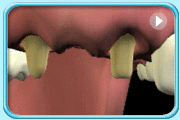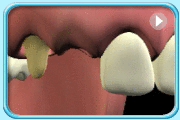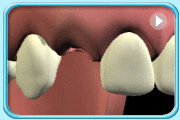Bridge
A bridge is a fixed prosthesis that is used to replace one or more missing teeth.
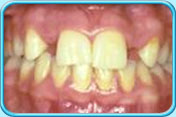 Before treatment
Before treatment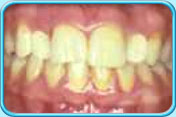 After treatment
After treatment
Purpose
- To replace missing teeth in order to prevent the drifting of neighbouring teeth into the tooth space, which will result in tilted teeth or abnormal bite.
- To restore the functions of teeth, including mastication, speech and esthetics.
Mechanism
- A bridge is being anchored by the teeth on either side of the tooth space; it can also be fixed by a metal wing extending from either side of the bridge.
- A bridge can be used together with crowns.
Types
Conventional Bridge
- Mechanism
- The crowns on both ends of the bridge act as anchors and hold the bridge in place.
- Properties
- Suitable for stress bearing area
- Bridge can be relatively longer
- Procedures for conventional bridge
- Grind the neighbouring teeth on both sides of the tooth space into appropriate shape according to the design of the bridge.
- Take impressions of the upper and lower dental arches and record the bite.
- Fabricate the bridge in the dental laboratory.
- Try in the finished bridge in the patient’s mouth and make adjustments if needed.
- Cement the bridge onto the prepared teeth.
Cantilever Bridge
- Mechanism
- The bridge is only supported or fixed on one neighbouring tooth.
- Properties
- Suitable for low stress bearing area
- Can only replace one missing tooth (For example, replacement of a lateral incisor by a cantilever bridge anchored by the central incisor)
- Procedures for cantilever bridge
- Grind the neighbouring tooth of the missing tooth into appropriate shape according to the design of the bridge.
- Take impressions of the upper and lower dental arches and record the bite.
- Fabricate the bridge in the dental laboratory.
- Try in the finished bridge in the patient’s mouth and make adjustments if needed.
- Cement the bridge onto the prepared tooth.
Maryland Bridge
- Mechanism
- The bridge is anchored by metal wings extending from both ends, and bond to the neighbouring teeth by cement.
- Properties
- Only suitable for low stress bearing area
- The teeth used to support the bridge should have enough enamel structure
- Procedures for Maryland bridge
- Grind the inner surfaces of neighbouring teeth of the missing tooth into appropriate shape according to the design of the bridge.
- Take impressions of the upper and lower dental arches and record the bite.
- Fabricate the bridge in the dental laboratory.
- Try in the bridge in the patient’s mouth and make adjustments if needed.
- Complete processing the bridge in the dental laboratory.
- Bond the bridge onto the prepared teeth with cement.
 Before treatment
Before treatment After treatment
After treatment